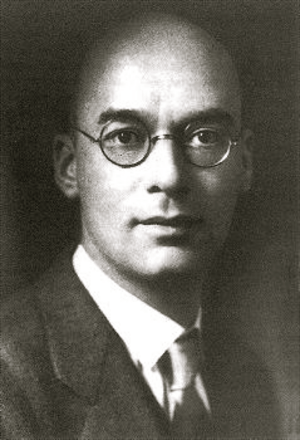Alfred Landé facts for kids
Quick facts for kids
Alfred Landé
|
|
|---|---|

Alfred Landé in 1940
|
|
| Born | 13 December 1888 Elberfeld, German Empire
|
| Died | 30 October 1976 (aged 87) |
| Nationality | German/American |
| Alma mater | University of Munich |
| Known for | Landé g-factor Landé interval rule Born–Landé equation |
| Scientific career | |
| Fields | Quantum mechanics |
Alfred Landé was an important German-American physicist. He lived from 1888 to 1976. He made big discoveries in quantum theory, which studies how tiny particles work. He is famous for the Landé g-factor and for explaining the Zeeman effect.
Contents
Life and Discoveries
Alfred Landé was born in Elberfeld, Germany, on December 13, 1888. This city is now part of Wuppertal.
Early Studies and World War I
In 1913, Landé was a student of Arnold Sommerfeld at the University of Munich. Sommerfeld sent him to work with another famous scientist, David Hilbert, at the University of Göttingen. There, Landé also met Max Born, who was a very important physicist.
At this time, scientists were excited about Niels Bohr's model of the atom. Many great minds, like Hilbert and Bohr himself, often visited Göttingen.
Landé finished his doctorate degree just before World War I began. He joined the Red Cross and worked on the eastern front for two years. Later, Max Born invited him to join a special army science group. They worked on finding artillery by sound. They also studied how crystals stick together and how much they can be squeezed. This research showed that electrons in atoms do not orbit like planets, which was a new idea.
Understanding Atoms and Spectroscopy
For the next seven years, Landé studied the structure of atoms very closely. In 1916, Sommerfeld started to create new rules for understanding atoms. Landé's ideas about electrons moving in cube or pyramid shapes inside atoms were very interesting to other scientists like Sommerfeld and Bohr.
In 1919, Landé started studying spectroscopy. This is a way to look at the light that atoms give off. He focused on helium atoms, which have more than one electron. Scientists like Friedrich Paschen had studied helium's light, but no one could explain it with theory. The light from helium looked like it came from two different kinds of helium. Today, we know this is because of something called electron spin.
Landé's work introduced important new ideas. He created a rule for adding two quantum-mechanical angular momenta (a measure of how much an object is spinning or orbiting). Later, quantum theory proved his ideas were correct.
The Landé g-factor and Zeeman Effect
From late 1920 to early 1921, Landé worked in Frankfurt. During this time, he discovered the famous Landé g-factor formula. He also explained the unusual Zeeman effect. The Zeeman effect is when light from atoms changes when they are in a magnetic field. The Landé g-factor helps explain these changes.
In 1923, Landé also described the Landé interval rule. This rule explains the connection between an electron's spin and its orbital angular momentum. In 1925, Ralph Kronig, who first thought of electron spin, worked as Landé's assistant.
Moving to America and Later Ideas
In 1929, Landé was invited to give lectures at Ohio State University in Columbus, Ohio. He liked it so much that he decided to move to the United States in 1930.
Landé was a leader in finding new ways to understand quantum theory. He wanted to make sure that quantum theory could predict things that could be tested in experiments. At that time, famous scientists like Niels Bohr and Albert Einstein had different ideas about how to understand quantum theory. New experiments were being done to test these ideas using single atoms, electrons, and photons (particles of light).
After 1950, Landé strongly disagreed with the popular "Copenhagen interpretation" of quantum theory. Like Einstein, he believed that physical processes should have a "real" description. He thought that the idea of "wave-particle duality" (that particles can act like waves and vice versa) was confusing. Instead, he developed a new way to explain quantum processes using only "particles," without needing "waves."
Landé based his new ideas on principles of symmetry and how things stay the same. He used "Duane's rule" for how momentum is exchanged with repeating structures in space. He also used Leibniz's "Principle of Cause-Effect Continuity" to explain why quantum processes seem to happen by chance. Landé's interpretation of quantum mechanics is considered a less common view today.
Alfred Landé passed away in Columbus, Ohio, on October 30, 1976.
See also
 In Spanish: Alfred Landé para niños
In Spanish: Alfred Landé para niños

